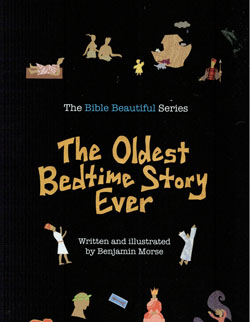Benjamin Morse, The Oldest Bedtime Story Ever, Orson and Company, (c) 2012, ISBN 978-0-9858136-0-5, 77 pages with illustrations, $30.
By Donald H. Harrison

 SAN DIEGO–The title of this book is intriguing; what can that oldest bedtime story possibly be? Once a parent and child begin this colorfully illustrated and judiciously edited book by author and artist Benjamin Morse, they are quickly introduced to highlights of the Bible starting with Creation in Genesis 1 and continuing through the Babylonian captivity in the Book of Daniel.
SAN DIEGO–The title of this book is intriguing; what can that oldest bedtime story possibly be? Once a parent and child begin this colorfully illustrated and judiciously edited book by author and artist Benjamin Morse, they are quickly introduced to highlights of the Bible starting with Creation in Genesis 1 and continuing through the Babylonian captivity in the Book of Daniel.
As one can see from the cover of the book, the illustrations are cut from paper, making it likely that The Oldest Bedtime Story Ever will be enjoyed by hobbyists as well as by families who want to introduce their children to translations of Hebrew Scriptures.
No doubt, the book will also be a refresher course for many parents. Many of us know the five books of the Torah because we read them every year in synagogue, but how many of us know, in order, the stories in our Psalms, or those of the Prophets?
Morse had to skip large portions of the Bible to keep his narrative both interesting and fitting for the ears of young children. Those stories addressed in his work are told in simplified, everyday language, with any explanations sought by children to be filled in by the parents or other adult readers.
The author’s version of the Ten Commandments is as follows: ” 1) Be a One-God people; 2) No idols; 3) No cursing My Holy Name; 4.) Rest on Sabbath; 5) Respect your parents; 6) No killing anyone; 7) Be Faithful to the one you love; 8) No stealing; 9) No lying; 10 No jealousy.”
Here is a one-page story about Elijah: “The more the people of Israel and Judah forgot about God’s holy laws, the more selfish they became. So some strange things started happening to the prophets. Elijah saw ravens bring him food and angels make him cake. He witnessed over fifty men who worshiped foreign gods burst into flames. And at the end of this life, he found himself swept up to heaven on a golden chariot.”
Each page is a collage, and this one (page 56) has a picture of a raven carrying a picnic basket in its talons; a cupcake (with a cherry on top); a sprawling man juxtaposed with a cartoon flame; and another man waving to his friends from a golden chariot.
When readers go to an index titled “the fine print” in the back of the book, we learn that Elijah in the cut out is dressed in a Windham Fabrics swatch sold at the Harriet Beecher Stowe house.
In a companion index titled “Read More” we also learn that Elijah’s adventures begin in 1 Kings 17, and that in 1 Kings 2 he ascends to heaven.
Bottom line: This book is fun. It’s easy to read. It may stimulate your children both artistically and religiously. Even though Morse remained faithful to the basic plot of the Bible, we are greatly benefited by his creativity. Each time you read this book, you will find in it something new.
*
Harrison is editor of San Diego Jewish World. He may be contacted at donald.harrison@sdjewishworld.com